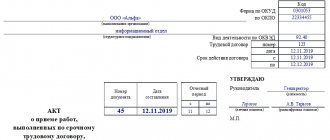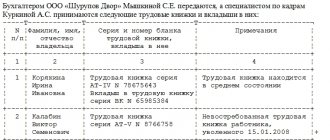A temporary employee is an employee with whom a fixed-term employment agreement has been concluded. As a rule, such employees are included in the staff when temporary work is needed: replacing an employee who has gone on maternity leave, seasonal work, etc. The dismissal of such specialists is carried out in a special manner.
A fixed-term employment contract is concluded when the employment relationship cannot be established for an indefinite period, or by agreement of the parties. The list of grounds for concluding this agreement is established by law. In what cases is it legal to conclude a fixed-term employment contract ?
Fixed-term employment contract - concept
A fixed-term contract is a document that confirms the existence of a business relationship between the person providing the work and the employee, and also reflects the conditions of the work process and is concluded between the parties for a strictly limited period.
Unlike open-ended contracts, which fix business relationships for an unlimited period of time, a fixed-term contract can be valid for a maximum of 5 years .
Typically, fixed-term contracts are drawn up when there is a need for activities that need to be completed within a strict time frame. This could be seasonal work, various types of activities, the relevance of which depends on the time of year, etc.
You can find the form for a standard fixed-term employment contract here.
With whom?
Labor contracts valid for a specific period are divided into the following main types :
- Agreements that take into account the type of activity and working conditions of the future employee, which are valid only for a certain period of time.
- Employment agreements valid for a limited period, which are concluded on the basis of an agreement signed by the employer with an individual looking for work.
Article 58 (Part 2) of the Labor Code of the Russian Federation allows the right not to take into account the type of activity expected of the employee, as well as the conditions of work-related processes, if there are cases recorded in Article 59 (Part 2).
Article 59 of the Labor Code contains information about persons with whom fixed-term contracts are concluded:
- Workers who are expected to work outside the territories of the Russian Federation.
- Persons who perform additional types of work that are not related to the work of the employer’s main specialization.
- Employees required for expansion of the enterprise (for no more than 1 year) .
- A category of workers recruited to work in enterprises that operate and are created on a temporary basis, as well as with persons performing pre-agreed types of work.
- Workers who are hired to perform a specific activity that has no specific completion date.
- Individuals performing activities to gain work experience or improve qualifications in a specialty, as well as those related to practice and some other educational processes.
- Groups of government officials whose election period has a specific time frame.
- Employees who are at workplaces on behalf of the employment service for the purpose of performing public work, as well as non-permanent activities.
- Individuals holding positions in the state civil service.
- Other groups of persons who are not included in the above categories, but are prescribed in the Labor Code or other legislative acts.
A fixed-term contract for individuals who will work abroad is signed for no more than 3 years (Article 338 of this code).
This group includes members of local government and political parties, officials, as well as a number of other government employees.
Advantages and disadvantages
Many employers who provide work to a new employee use a fixed-term type of employment agreement.
The positive side of this document is a more simplified dismissal procedure , in contrast to an open-ended agreement. When the contract expires, thereby losing its validity, which means the employer can terminate the contract with the employee without stating the reasons for dismissal .
A fixed-term contract is a kind of universal form for realizing the wishes of the employer, who can either extend a fixed-term employment document or resort to drawing up an open-ended agreement.
The main advantage is the possibility of dismissing an employee due to the expiration of the contract without specifying any reason.
The negative aspects of a fixed-term contract include the fact that such a document is concluded (in accordance with Article 59 of the Labor Code) only in certain cases .
Also among the disadvantages is the inability of the employer to terminate a fixed-term contract with an employee who is in a situation. This means that dismissing a pregnant woman is permitted by law only in the event of complete liquidation of the organization .
Read our article about how to fire a pregnant woman.
Dismissal at the request of the employer
The employee’s boss can also initiate the termination of employment agreements, but he must have reasonable evidence of his subordinate’s guilt in any disciplinary offense. Dismissal at the request of the employer always occurs on the basis of some article of labor legislation. The main reasons for terminating a fixed-term agreement include:
- Liquidation of the organization, resulting in the dissolution or reduction of employees;
- Selling an organization to a new manager;
- Identification of the fact of a serious violation of the company’s labor regulations by a subordinate;
- Negligence of an employee in fulfilling his official obligations, which greatly affects the deterioration of the quality of the services provided to him;
- If the employee is a financially responsible person, then the reason for dismissal may be a shortage of goods or the detection of theft of commercial valuables;
- If an employee has access to a trade secret, it will be a serious violation to disclose this data to third parties who do not have the right to know it.
When terminating a contract with a temporary employee, the manager must comply with a number of rules, including, for example, the inability to dismiss subordinates during sick leave or on a day off, as well as when the person is on annual leave.
The process of registering an employee for employment
In order for an individual to officially begin the work process on the basis of a fixed-term contract, it is necessary to perform a number of the following actions :
- Draw up an employment agreement on the part of the employer and employee (taking into account the above-mentioned features).
- Using form T-1 (for registration of one employee) or T-1A (for several persons), the enterprise must publish an order for employment.
- Entry into the work book.
The rules for filling out a work book are carried out in accordance with the general procedure, in accordance with paragraph 1 of Instruction No. 69, effective from 10.10.2003.
The employer is required to create an individual card (form T-2) and enter the necessary information into it.
Main reasons for termination of STD
According to the Labor Code, the employment of a new employee by default is carried out on an indefinite basis. However, there are exceptions: the law lists in detail cases where the nature and conditions of work either prescribe or allow the employer to enter into an agreement indicating the deadline for its completion.
Then the contract specifies either a specific date when its validity expires, or indicates a specific event after which the employee’s services will no longer be needed.
In any case, as the agreed end date of a fixed-term contract approaches, the employer begins to think: is it necessary to terminate such a contract and how?
By law, any dismissal must have a reason, which must be indicated in the documents. STD has only one particular reason for dismissal, which is not characteristic of BTC - namely, the expiration of the employment contract. All other grounds are common to both fixed-term and open-ended employment contracts.
Let us consider all these reasons in turn, which we will conditionally divide into five categories:
- Expiration of the STD;
- On agreement of the parties;
- At the initiative of the employee;
- At the initiative of the employer;
- Due to independent circumstances.
Expiration of the STD
- Return to work of the main employee. Then the deputy is forced to leave. For example, a young mother returning from maternity leave or the recovery of a key employee;
- The end of work, temporary or seasonal, for which the employee was hired. For example, the end of the harvest or the completion of equipment installation;
On agreement of the parties
Dismissal by agreement of the parties is considered the most “peaceful” reason. In theory, this means that both the employer and the employee have decided not to continue the employment relationship and are terminating it by mutual agreement.
At the initiative of the employee
Dismissal at one's own request may have the following reasons:
- Serious illness of the employee himself or the onset of disability, in which work becomes impossible;
- Serious illness of one of the employee’s family members and, as a result, the need to care for the sick;
- Violation by the employer of the Labor Code, the terms of the contract or his duties. For example, if in the contract the employer agreed to organize hot meals for the harvesters and did not fulfill the obligation;
- Changing the employee’s place of residence or moving with a spouse;
- Transfer of an employee to another employer or assumption of an elective position;
- Refusal of the employee to continue the employment relationship due to the reorganization of the company, change of owner or change in the type of enterprise;
- Refusal of an employee to follow the employer if he moves to another area.
The employee is obliged to notify the administration of his intention two weeks before actually leaving work. During this period, the employee can withdraw his application in writing if he has changed his mind and another person has not yet been hired in his place. After this period, the employee has the right not to go to work.
If a fixed-term contract was concluded for a period of up to two months or for seasonal work, the employer must be notified three days before dismissal. However, by mutual agreement, “working off” may not be required at all or may be reduced.
In case of unlawful resistance on the part of the employer - failure to admit his guilt or a valid reason - the employee can file a complaint with the court or the Labor Dispute Commission.
At the initiative of the employer
An employer may terminate relations with an employee early on the following grounds:
- Liquidation of the organization;
- Reducing the number of employees;
- Change of owner (applies to the manager and his deputy, as well as the chief accountant);
- The employee systematically evaded the performance of his official duties or performed them improperly;
- The employee violated labor discipline;
- It turned out that the employee presented false documents during employment or his qualifications did not meet the required level (determined during certification);
- Causing significant harm to the organization;
- Committing theft or disclosing trade secrets.
If an employee is on sick leave or on vacation, during this period he cannot be dismissed at the initiative of the employer. The exception is the liquidation of an organization.
Dismissal due to independent circumstances
In some cases, dismissal is forced, although neither the employee nor the employer wanted it.
This occurs under the following circumstances:
- Conscription of an employee to military or alternative civilian service;
- Transfer of a person to a place of imprisonment in connection with a court verdict;
- Reinstatement of an employee to his previous position in connection with an official decision of the labor inspectorate or court;
- Death of an employee or the occurrence of emergency circumstances (war, earthquake, major accident, epidemic).
Classification of fixed-term employment contracts
- By agreement of the parties
- At the same time
- For temporary work
- With an individual entrepreneur
A document of this type can be drawn up with an employee invited to perform the duties of another person working in the organization who is absent from work for some reason, or with employees whose work is possible only in one of the seasons of the year.
Download the form for a fixed-term employment contract by agreement of the parties from us for free.
The Labor Code contains Article 44 , which describes in detail the rights of employees working in multiple jobs.
If the activity specified in the fixed-term contract is part-time work (performed during a period of time free from other work), then it is necessary to specify in detail the working day schedule and the specifics of the job function in the contract. The validity period of the document is agreed upon by both parties.
Sample employment contract with a part-time worker.
Such fixed-term contracts are concluded with a category of workers who perform various types of temporary activities. These types include work that can be completed within a period of up to 60 days.
Download the completed form here.
This fixed-term contract implies the presence of social guarantees for the employee and tax payments from the legal entity. the cases described in Article 59 occur .
Click here for free.
Dismissal at the initiative of the employee
Severance of employment relations with the employer at the personal request of the employee occurs, as a rule, when the latter finds more favorable employment conditions or wants to terminate cooperation with an unscrupulous employer due to a conflict. Also, compelling circumstances for early termination of an employment contract include:
- An employee receives an injury that leads to disability and the inability to continue working at this enterprise;
- A citizen has a dependent close relative who requires constant attention and care;
- The employer violates the labor obligations specified in the agreement with the employee;
- Relocation of an employee with his family to another locality for permanent residence;
- An employee is transferred to a higher position;
- There was a change in the previous working conditions that did not suit the employee.
The employee must notify the boss of early dismissal by submitting a corresponding application exactly 14 days before the date of expected departure. If the term of the fixed-term agreement does not exceed six months, the employee should be informed of the dismissal three days before it.
Additional agreement
Each change in the essential terms of the contract must be agreed upon with the employee 2 months in advance (Article 74 of the Labor Code of the Russian Federation).
But if the employee does not mind, then in order to avoid conflict situations between the parties in the future, an additional agreement can be concluded ( Article 72 of the Labor Code of the Russian Federation ).
When drawing up this document, you must comply with the law , take into account the interests of the employee, and also obtain his consent to the entry into force of the additional agreement.
When registering you must indicate:
- type and number of supporting document,
- the main document, which includes an additional agreement, the name of the organization,
- the initial view of that part of the employment contract that will be modified,
- corrected version,
- signatures of both parties.
The form of the additional agreement may look like this:
ADDITIONAL AGREEMENT No. ______
to contract No. _____ dated “___” ______ 20__
_______ "__" ____________ 20__
__________, hereinafter referred to as the “Employer”, represented by the director ____________ acting on the basis of ______, on the one hand, and __________________________, hereinafter referred to as the “Employee”, represented by ___________, passport _________, on the other hand, both hereinafter referred to as the “Parties”, entered into this Additional Agreement No. ____ to Agreement No. _______ dated “___”_______ 20___. (hereinafter referred to as the Agreement) as follows:
In connection with________________________________ 1. Clause ______ of contract No. ________ shall be stated in a new edition: “_____ (clause of the contract where new terms are already indicated).” 2. Otherwise, the terms of the agreement remain unchanged. 3. This Additional Agreement is drawn up in two copies having equal legal force, one copy for each of the parties. 4. This additional agreement comes into force from the moment it is signed by the parties.
Signatures of the parties.









